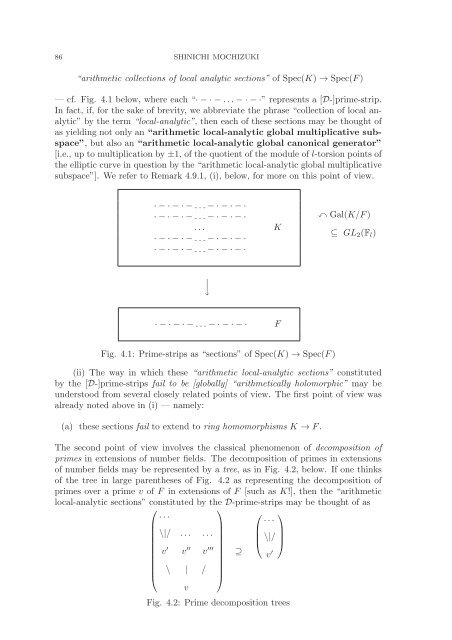Inter-universal Teichmuller Theory I: Construction of Hodge Theaters
Inter-universal Teichmuller Theory I: Construction of Hodge Theaters
Inter-universal Teichmuller Theory I: Construction of Hodge Theaters
You also want an ePaper? Increase the reach of your titles
YUMPU automatically turns print PDFs into web optimized ePapers that Google loves.
86 SHINICHI MOCHIZUKI<br />
“arithmetic collections <strong>of</strong> local analytic sections” <strong>of</strong> Spec(K) → Spec(F )<br />
— cf. Fig. 4.1 below, where each “·−·−...−·−·” represents a [D-]prime-strip.<br />
In fact, if, for the sake <strong>of</strong> brevity, we abbreviate the phrase “collection <strong>of</strong> local analytic”<br />
by the term “local-analytic”, then each <strong>of</strong> these sections may be thought <strong>of</strong><br />
as yielding not only an “arithmetic local-analytic global multiplicative subspace”,<br />
but also an “arithmetic local-analytic global canonical generator”<br />
[i.e., up to multiplication by ±1, <strong>of</strong> the quotient <strong>of</strong> the module <strong>of</strong> l-torsion points <strong>of</strong><br />
the elliptic curve in question by the “arithmetic local-analytic global multiplicative<br />
subspace”]. We refer to Remark 4.9.1, (i), below, for more on this point <strong>of</strong> view.<br />
·−·−·−...−·−·−·<br />
·−·−·−...−·−·−·<br />
... K<br />
·−·−·−...−·−·−·<br />
·−·−·−...−·−·−·<br />
Gal(K/F)<br />
⊆ GL 2 (F l )<br />
⏐<br />
↓<br />
·−·−·−...−·−·−·<br />
F<br />
Fig. 4.1: Prime-strips as “sections” <strong>of</strong> Spec(K) → Spec(F )<br />
(ii) The way in which these “arithmetic local-analytic sections” constituted<br />
by the [D-]prime-strips fail to be [globally] “arithmetically holomorphic” may be<br />
understood from several closely related points <strong>of</strong> view. The first point <strong>of</strong> view was<br />
already noted above in (i) — namely:<br />
(a) these sections fail to extend to ring homomorphisms K → F .<br />
The second point <strong>of</strong> view involves the classical phenomenon <strong>of</strong> decomposition <strong>of</strong><br />
primes in extensions <strong>of</strong> number fields. The decomposition <strong>of</strong> primes in extensions<br />
<strong>of</strong> number fields may be represented by a tree, as in Fig. 4.2, below. If one thinks<br />
<strong>of</strong> the tree in large parentheses <strong>of</strong> Fig. 4.2 as representing the decomposition <strong>of</strong><br />
primes over a prime v <strong>of</strong> F in extensions <strong>of</strong> F [such as K!], then the “arithmetic<br />
local-analytic sections” constituted by the D-prime-strips may be thought <strong>of</strong> as<br />
⎛<br />
⎞<br />
...<br />
⎛ ⎞<br />
...<br />
\|/ ... ...<br />
⎜<br />
⎝ \|/ ⎟<br />
⎠<br />
v ′ v ′′ v ′′′<br />
⊇<br />
v ′ ⎜<br />
⎝<br />
\ | / ⎟<br />
⎠<br />
v<br />
Fig. 4.2: Prime decomposition trees
















